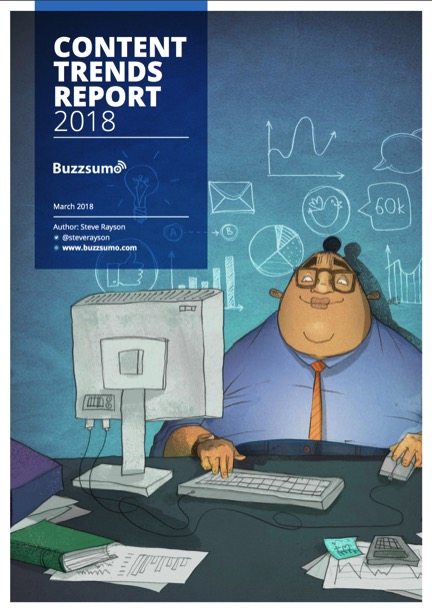What’s up is information density. You could call it shocking.
In fact, in 2014, Mark Schaefer characterized the phenomena as “content shock,” where the volume of content is so intense the idea of succeeding with content marketing becomes unviable for many businesses in many niches.
Mark wrote the foreword to the new Content Trends Report 2018, authored by Steve Rayson of Buzzsumo. In it Mark writes:
“The economic value of simply publishing content is zero – unless it is seen and shared. When even the most successful content producers are seeing their posts, videos, and infographics stall against the wall of content shock, it is time for us all to recognize the battlefield before us.”
He then turns it over to Steve who lets the data do the talking.
The timely report—mostly about the decline in social sharing—is available free here.
Social referral traffic is down
Though the report is full of data-driven insights, its main bullet is engagement across social networks for publishers and marketers has nose-dived since 2015.
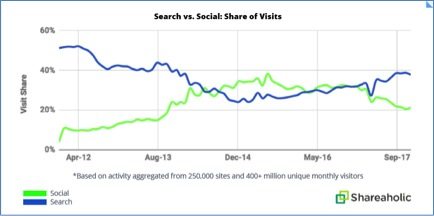
A major shift has occurred in referral traffic. Data from Shareaholic shows traffic from social peaked in late 2014 and has declined since. Rayson says the decline in social referrals is almost entirely due to Facebook.
He also points out the data relates primarily to publishers. When you look across the entire universe of websites, traffic from Google has always exceeded social, according to data from Jumpshot.
Content sharing is down
“Your content approach from three years ago is 50% less effective,” writes Rayson. He’s speaking to the report’s most alarming conclusion, an update on social media shares.
Based on a random sample of 100m posts from 2017, Buzzsumo found median shares per post has reduced 50% since 2015.
- Median shares in 2015 = 8
- Median shares in 2017 = 4
Also, 90% of content earns less than 62 shares.
As anemic as the numbers sound, they may even be worse because the Buzzsumo database seldom indexes content with zero shares—and there’s plenty of that.
Three reasons sharing and engagement is down
Competition
We’re back on the subject of information density again. Simply stated, when the volume of content rises, shares per post declines.
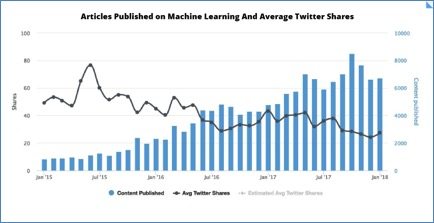
Content volume up, social sharing down. To demonstrate the point, Buzzsumo chose to depict a chart plotting the volume of content published about “machine learning” and the average Twitter shares earned.
Also—and clearly—the data suggests publishers enjoy much more social sharing when they get in early.
Facebook changes
Facebook’s changed its algorithm a number of times, but the theme remains the same: content from publishers and brands will be filtered, demoted and appear far less on Facebook feeds.
The antidote according to them: Facebook advertising.
Private Sharing
Data from GetSocial suggests private sharing (mostly via messenger apps) is more than twice as large as public sharing.
Business Insider reports more people now use social messaging apps vs. social media apps.
Has any content survived the sharing slump?
The Content Trends Report 2018 addresses the slump in further detail and makes the case for a broad decline in social sharing by calling out several types of content, publishers, and marketing blogs. I’ll summarize below.
But stick around for what follows: a glimmer of good news concerning content that appears to be surviving the slump.
Bad news for social shares…
- Top Buzzfeed listicles (“26 Pictures That Will… “) went from a high of 2.6m shares pre-2017 and has topped out at only .53m since.
- Many big viral sites such as Upworthy and Playbuzz have seen major declines in total and average shares since 2015.
- Top marketing blogs including HubSpot, Buffer, Moz, and Social Media Examiner have all experienced massive declines in social shares.
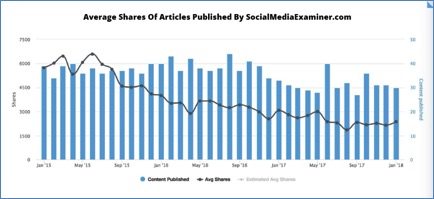
Good news for social shares…
- If you’re in the business of creating viral music videos, millions of people continue to share them.
- The most shared music video on YouTube in 2017 was ‘Despacito’ with over 22m shares on social networks and 25m likes.
- The other area where viral content continues to gain millions of shares and high Facebook engagement has been political content. Rayson says it appears there has been more tribal and partisan sharing of content in recent years.
- Some sites, including Harvard Business Review, The Economist, and The New York Times, have bucked the general trend and seen increased shares. Steve submits quality, research, authority, consistency, and topic matter may explain the big numbers.
- Evergreen content builds links and earns shares.
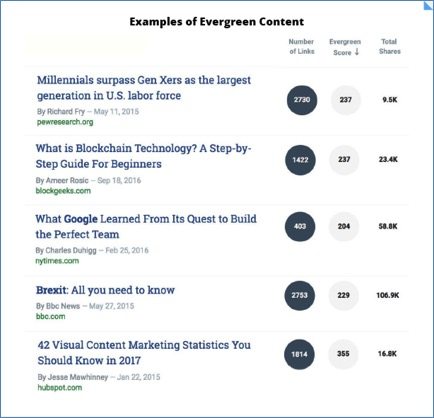
What’s “Evergreen?”
Content marketers don’t universally agree on what constitutes evergreen content or even if such a thing exists. Rayson submits his observations in the report claiming posts that qualify as evergreen have at least one of the following characteristics. They are:
- Research-based
- Reference-style (such as “visual marketing statistics”)
- Updated regularly
Facebook’s changing. Are you?
As it approaches its conclusion, Buzzsumo’s report comes back to Facebook yet again. Readers are reminded that Facebook engagement declined 20 percent in 2017 and the trend continues.
A 2018 update to the Facebook algorithm that prioritizes content from friends, family and groups will further reduce the visibility of publisher content in the news feed. Obviously, engagement will take a hit too. You can’t engage with content you never see.
The report concludes with a 10-point action plan for content marketers and publishers.
- Be clear on your objectives for content and social media
- Don’t chase shares with viral content and headlines
- Build authority and an audience before jumping on trends
- Focus on the long tail
- Build your audience and work on direct distribution models
- Encourage user-generated content
- Don’t forget promotion
- Focus on high quality content
- Reconsider the potency of SEO
- Less content is probably more
Let’s revert to number 7. Steve writes, “In a world of content saturation you cannot publish and hope people will find your content. You need a promotion strategy. This may include paid promotion, outreach, influencer sharing, and staff sharing.”
Scale your reach with content discovery
You heard from me in a recent post on the Taboola blog, How to Scale Your Reach When Search and Social Ads are Budget Busters.
In light of the conclusion of Buzzsumo’s research regarding the challenge of acquiring shares via organic social media posts, it seems worthwhile revisiting the conclusion of the post…
“If expanding your audience is a critical challenge for your brand, native advertising presents a powerful third option, a potential new frontier to make your voice heard.”
An investment in the Taboola content discovery network enables you to scale to reach a larger audience.
